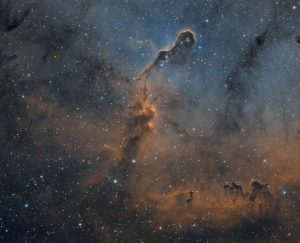IC 1396 is one of the largest ionized gas nebula in the night sky (occupies full 3 degrees in the sky — which is six diameters of the Moon when seen from Earth). It is located in the constellation of Cepheus, some 2,450 ly away from Earth. The photograph below made in narrowband shows only the part of the nebula that features its most prominent element, an elongated dark globule that is being compressed by the surrounding ionized gas — informally dubbed Elephant’s Trunk and more formally designated as IC 1396A. The light that bounces within and out of the huge cloud of gas originates from a massive O-type star designated HD 206267 (actually a triple star system) which is not captured in the frame of this photograph (it is somewhere upper-left from the end of the ‘trunk’, for example, in the center of this image).
IC 1396A is a star-forming region in which scientists observed more than 100 pre-main sequence stars through a use multiband imaging (including most notably the Spitzer Space Telescope). These protostars are not warm enough to emit in visible wavelengths, but emit strongly in infrared.
Data and processing: Goran Petrov
License: Creative Commons BY NC (free for non-commercial use, with attribution).
Click on the image to view in full size.
Location: Petralica, Rankovce, Macedonia
Date: 2018-09-06 and 2019-09-09
Total integration time: 12 hours
Camera: ATIK One 9.0, cooled to -20C and -15C
Telescope: Takahashi FSQ 106 ED refractor
Filters:
Ha, SII, OIII: total of 70 x 10min
Processed in PixInsight.
This photograph was made with the use of narrowband filters.
Narrowband Information was mapped to RGB (with a modified Hubble Palette).
Luminance information was synthetized from narrowband.
